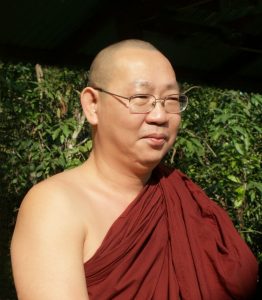Table of Contents
David Sudar Lineage
My primary lineage is the Theravada-Vipassana Buddhist tradition, particularly as passed through the Burmese monk Shwe Oo Min Sayadaw to his successor & my core teacher, Sayadaw U Tejaniya.
 Sayadaw U Tejaniya Brief Bio:
Sayadaw U Tejaniya Brief Bio:
Sayadaw U Tejaniya began his Buddhist training as a young teenager in Myanmar under the late Shwe Oo Min Sayadaw (1913–2002). After a career in business and life as a householder, he became a permanent monk in 1996 at the age of 36. He now teaches meditation at Shwe Oo Min Dhamma Sukha Forest Meditation Center in Yangon, Myanmar.
His style is marked by a relaxed demeanor and easy sense of humor that belies a commitment to awareness which he encourages his students to apply in every aspect of their lives. Here is a four-page autobiography he wrote in the mid 2000’s (starts on page 26).
Other Key Theravada Influences:
Also within the Theravada tradition, my practice and teachings are greatly informed by:
- Early Buddhism; the earliest known Buddhist teachings, which are found in the Pali Canon (technically, pre-Theravada).
- Contemporary monastic-scholars who teach from an Early Buddhism perspective, including Bhikkhu Analayo, Thanissaro Bhikkhu & Bhikkhu Bodhi.
- A handful of deeply practiced Western teachers, including Gil Fronsdal, Joseph Goldstein, Mark Nunberg, Rob Burbea, and a few of the senior Western students of U Tejaniya, including my mentor Carol Wilson, as well as Steve Armstrong and Andrea Fella.
- The Thai Forest tradition; particularly the teachings of Ajahn Chah, Ajahn Sumedho, Ajahn Pasanno, Ajahn Jayasaro, Ajahn Sucitto, and Pramote Pamojjo.
- The Burmese Vipassana tradition; apart from U Tejaniya, I’ve also greatly benefited from the teachings of S.N Goenka & Mahasi Sayadaw.
Earlier in my spiritual journey, I also spent time immersed in Soto Zen Buddhism, classical Yoga, and Advaita Vedanta. While I’ve found a spiritual home with Theravada Buddhism and don’t actively study or practice these traditions anymore, they have certainly informed my sensibilities & the ways I relate to the dharma.
What is Theravada Buddhism (and Vipassana)?
The first ~200 years after the Buddha died, there weren’t different schools & sects of Buddhism. There were just followers of the Buddha. However, once different schools broke off, eventually forming Mahayana & Vajrayana Buddhism, among others, the original group that remained intact was called Theravada, or “the way of the elders.” Over the past 2,000+ years, this lineage has maintained a continuous presence and nowadays is the dominant tradition in Thailand, Sri Lanka, Myanmar, Laos, and Cambodia.
The Theravada tradition presents a well-rounded spiritual path aimed at awakening, and involves three primary trainings: ethics, wisdom & meditation.
Vipassana is its style of meditation that focuses on developing wisdom, and is typically translated as Insight Meditation. This style is often paired with samatha meditation (aka concentration or calm-abiding), and together these two form the core of the Theravada meditative practice. They are both rooted in mindfulness.
Although, a better term than vipassana to describe what I do would be Satipatthana meditation, which refers to the discourse where the Buddha laid out his basic meditation approach, enveloping both vipassana and samatha. One of my favorite all-time books begins with a translation of the 10ish page discourse, and proceeds to break it down in-depth.
If you’re interested in a deeper dive into all this, this article by Gil Fronsdal offers a fantastic overview of Theravada Buddhism. I also wrote a short article describing the essence of Vipassana.
